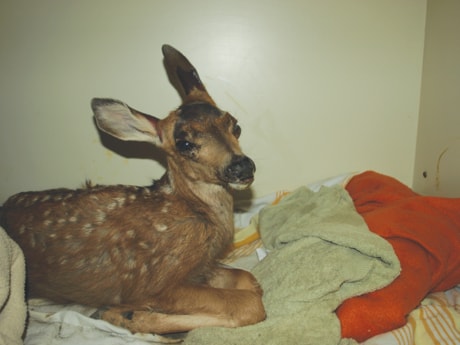Medicine River Wildlife Centre staff are closely monitoring a young traumatized fawn who was rescued from an extremely narrow and deep pit on the City of Red Deer Wastewater Treatment Plant site in north Red Deer.
Since the fawn’s admittance on Monday, staff in the intensive care unit at the wildlife hospital have been hydrating and feeding the young fawn. One volunteer stayed up until 1 a.m. with the little one to make sure she was getting the care she needed.
The fawn has been prescribed a homeopathic treatment for stress and head trauma. When she arrived at the centre, she was extremely dehydrated and twisted so tight she could not straighten her limbs.
Now the young mule deer, believed to be two or three weeks old, is suffering from head trauma causing temporary blindness. If the swelling in the brain goes down, her vision may return.
Executive director Carol Kelly said there is slight improvement in the fawn’s condition but the staff are still taking her recovery one day at a time.
She said they have never seen a case like this before. A few years ago, the centre took care of a buck who was hit by a car and was temporarily blinded.
“One day I went in to give him his treatment and he looked at me and ran at me,” said Carol Kelly. “I thought, ‘Oh, I think he’s better now.’”
Kelly said the fawn’s trauma is so different it is difficult to say whether or not she will regain her sight. She may have been in the hole for up to a week thrashing about crying for her mother.
Kelly said on Monday evening the fawn tried to straighten her body out.
“It is sitting up but it can’t stand,” said Kelly. “What they are doing now is switching it from one side to another. Then they give it a little physiotherapy. But we don’t like to handle it a lot because it is scared of us.”
Staff are also concerned the fawn may develop capture myopathy, where stress causes the liver and kidneys to shut down, causing death.
This is seen quite often in animals when they are chased or in a stressful situation for a long time.
No doubt the stress of being in a dark and narrow hole for several days and the sound of a backhoe used to rescue the fawn has contributed to her stress levels.
Stephanie Kelly, education assistant, said sometimes it takes days or even weeks for capture myopathy to hit the body.
“But who knows maybe she will take a turn for the best,” said Stephanie. “It’s really quite iffy right now.”
Should the fawn recover she will be released in the area where she was found. They will try to call back her mother with a deer distress call. If the mother does not return, they will find a foster mother for the fawn in another area.
crhyno@www.reddeeradvocate.com
